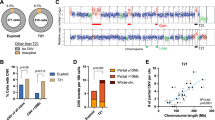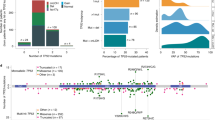Abstract
The complex chromosomal aberrations found in therapy-related acute myeloid leukemia (t-AML) suggest that the DNA double-strand break (DSB) response may be altered. In this study we examined the DNA DSB response of primary bone marrow cells from t-AML patients and performed next-generation sequencing of 37 canonical homologous recombination (HR) and non-homologous end-joining (NHEJ) DNA repair genes, and a subset of DNA damage response genes using tumor and paired normal DNA obtained from t-AML patients. Our results suggest that the majority of t-AML patients (11 of 15) have tumor-cell intrinsic, functional dysregulation of their DSB response. Distinct patterns of abnormal DNA damage response in myeloblasts correlated with acquired genetic alterations in TP53 and the presence of inferred chromothripsis. Furthermore, the presence of trisomy 8 in tumor cells was associated with persistently elevated levels of DSBs. Although tumor-acquired point mutations or small indels in canonical HR and NHEJ genes do not appear to be a dominant means by which t-AML leukemogenesis occurs, our functional studies suggest that an abnormal response to DNA damage is a common finding in t-AML.
This is a preview of subscription content, access via your institution
Access options
Subscribe to this journal
Receive 12 print issues and online access
$259.00 per year
only $21.58 per issue
Buy this article
- Purchase on Springer Link
- Instant access to full article PDF
Prices may be subject to local taxes which are calculated during checkout







Similar content being viewed by others
Accession codes
References
Vardiman JW, Thiele J, Arber DA, Brunning RD, Borowitz MJ, Porwit A et al. The 2008 revision of the World Health Organization (WHO) classification of myeloid neoplasms and acute leukemia: rationale and important changes. Blood 2009; 114: 937–951.
Mauritzson N, Albin M, Rylander L, Billstrom R, Ahlgren T, Mikoczy Z et al. Pooled analysis of clinical and cytogenetic features in treatment-related and de novo adult acute myeloid leukemia and myelodysplastic syndromes based on a consecutive series of 761 patients analyzed 1976-1993 and on 5098 unselected cases reported in the literature 1974-2001. Leukemia 2002; 16: 2366–2378.
Leone G, Mele L, Pulsoni A, Equitani F, Pagano L . The incidence of secondary leukemias. Haematologica 1999; 84: 937–945.
Kayser S, Dohner K, Krauter J, Kohne CH, Horst HA, Held G et al. The impact of therapy-related acute myeloid leukemia (AML) on outcome in 2853 adult patients with newly diagnosed AML. Blood 2011; 117: 2137–2145.
Smith SM, Le Beau MM, Huo D, Karrison T, Sobecks RM, Anastasi J et al. Clinical-cytogenetic associations in 306 patients with therapy-related myelodysplasia and myeloid leukemia: the University of Chicago series. Blood 2003; 102: 43–52.
Schoch C, Kern W, Schnittger S, Hiddemann W, Haferlach T . Karyotype is an independent prognostic parameter in therapy-related acute myeloid leukemia (t-AML): an analysis of 93 patients with t-AML in comparison to 1091 patients with de novo AML. Leukemia 2004; 18: 120–125.
Li FP, Fraumeni JF Jr . Prospective study of a family cancer syndrome. JAMA 1982; 247: 2692–2694.
Birch JM, Alston RD, McNally RJ, Evans DG, Kelsey AM, Harris M et al. Relative frequency and morphology of cancers in carriers of germline TP53 mutations. Oncogene 2001; 20: 4621–4628.
Holmfeldt L, Wei L, Diaz-Flores E, Walsh M, Zhang J, Ding L et al. The genomic landscape of hypodiploid acute lymphoblastic leukemia. Nature Genet 2013; 45: 242–252.
Guillem V, Tormo M . Influence of DNA damage and repair upon the risk of treatment related leukemia. Leuk Lymphoma 2008; 49: 204–217.
Seedhouse C, Faulkner R, Ashraf N, Das-Gupta E, Russell N . Polymorphisms in genes involved in homologous recombination repair interact to increase the risk of developing acute myeloid leukemia. Clin Cancer Res: 2004; 10: 2675–2680.
Shih AH, Chung SS, Dolezal EK, Zhang SJ, Abdel-Wahab OI, Park CY et al. Mutational analysis of therapy-related myelodysplastic syndromes and acute myelogenous leukemia. Haematologica 2013; 98: 908–912.
Pedersen-Bjergaard J, Andersen MK, Andersen MT, Christiansen DH . Genetics of therapy-related myelodysplasia and acute myeloid leukemia. Leukemia 2008; 22: 240–248.
Ben-Yehuda D, Krichevsky S, Caspi O, Rund D, Polliack A, Abeliovich D et al. Microsatellite instability and p53 mutations in therapy-related leukemia suggest mutator phenotype. Blood 1996; 88: 4296–4303.
Andersen MK, Christiansen DH, Pedersen-Bjergaard J . Centromeric breakage and highly rearranged chromosome derivatives associated with mutations of TP53 are common in therapy-related MDS and AML after therapy with alkylating agents: an M-FISH study. Genes Chromosomes Cancer 2005; 42: 358–371.
Link DC, Schuettpelz LG, Shen D, Wang J, Walter MJ, Kulkarni S et al. Identification of a novel TP53 cancer susceptibility mutation through whole-genome sequencing of a patient with therapy-related AML. JAMA 2011; 305: 1568–1576.
Goodarzi AA, Jeggo PA . The repair and signaling responses to DNA double-strand breaks. Adv Genet 2013; 82: 1–45.
Ramsingh G, Jacoby MA, Shao J, De Jesus Pizzaro RE, Shen D, Trissal M et al. Acquired copy number alterations of miRNA genes in acute myeloid leukemia are uncommon. Blood 2013; 122: e44–e51.
Walter MJ, Payton JE, Ries RE, Shannon WD, Deshmukh H, Zhao Y et al. Acquired copy number alterations in adult acute myeloid leukemia genomes. Proc Natl Acad Sci USA 2009; 106: 12950–12955.
Subramanian A, Tamayo P, Mootha VK, Mukherjee S, Ebert BL, Gillette MA et al. Gene set enrichment analysis: a knowledge-based approach for interpreting genome-wide expression profiles. Proc Natl Acad Sci USA 2005; 102: 15545–15550.
Zeller KI, Jegga AG, Aronow BJ, O'Donnell KA, Dang CV . An integrated database of genes responsive to the Myc oncogenic transcription factor: identification of direct genomic targets. Genome Biol 2003; 4: R69.
Luo H, Li Q, O'Neal J, Kreisel F, Le Beau MM, Tomasson MH . c-Myc rapidly induces acute myeloid leukemia in mice without evidence of lymphoma-associated antiapoptotic mutations. Blood 2005; 106: 2452–2461.
Rogakou EP, Boon C, Redon C, Bonner WM . Megabase chromatin domains involved in DNA double-strand breaks in vivo. J Cell Biol 1999; 146: 905–916.
Bonner WM, Redon CE, Dickey JS, Nakamura AJ, Sedelnikova OA, Solier S et al. GammaH2AX and cancer. Nat Rev Cancer. 2008; 8: 957–967.
Rausch T, Jones DT, Zapatka M, Stutz AM, Zichner T, Weischenfeldt J et al. Genome sequencing of pediatric medulloblastoma links catastrophic DNA rearrangements with TP53 mutations. Cell 2012; 148: 59–71.
Stephens PJ, Greenman CD, Fu B, Yang F, Bignell GR, Mudie LJ et al. Massive genomic rearrangement acquired in a single catastrophic event during cancer development. Cell 2011; 144: 27–40.
Fairbairn DW, Olive PL, O’Neill KL . The comet assay: a comprehensive review. Mutation research 1995; 339 (1): 37–59.
Vafa O, Wade M, Kern S, Beeche M, Pandita TK, Hampton GM et al. c-Myc can induce DNA damage, increase reactive oxygen species, and mitigate p53 function: a mechanism for oncogene-induced genetic instability. Mol Cell 2002; 9: 1031–1044.
Karlsson A, Deb-Basu D, Cherry A, Turner S, Ford J, Felsher DW . Defective double-strand DNA break repair and chromosomal translocations by MYC overexpression. Proc Natl Acad Sci USA. 2003; 100: 9974–9979.
Ray S, Atkuri KR, Deb-Basu D, Adler AS, Chang HY, Herzenberg LA et al. MYC can induce DNA breaks in vivo and in vitro independent of reactive oxygen species. Cancer Res 2006; 66: 6598–6605.
Cancer Genome Atlas Research N. Genomic and epigenomic landscapes of adult de novo acute myeloid leukemia. New Eng J Med 2013; 368: 2059–2074.
Jones L, Wei G, Sevcikova S, Phan V, Jain S, Shieh A et al. Gain of MYC underlies recurrent trisomy of the MYC chromosome in acute promyelocytic leukemia. J Exp Med 2010; 207: 2581–2594.
Li Z, Owonikoko TK, Sun SY, Ramalingam SS, Doetsch PW, Xiao ZQ et al. c-Myc suppression of DNA double-strand break repair. Neoplasia 2012; 14: 1190–1202.
Celeste A, Petersen S, Romanienko PJ, Fernandez-Capetillo O, Chen HT, Sedelnikova OA et al. Genomic instability in mice lacking histone H2AX. Science 2002; 296: 922–927.
Celeste A, Difilippantonio S, Difilippantonio MJ, Fernandez-Capetillo O, Pilch DR, Sedelnikova OA et al. H2AX haploinsufficiency modifies genomic stability and tumor susceptibility. Cell 2003; 114: 371–383.
Bassing CH, Suh H, Ferguson DO, Chua KF, Manis J, Eckersdorff M et al. Histone H2AX: a dosage-dependent suppressor of oncogenic translocations and tumors. Cell 2003; 114: 359–370.
Riches LC, Lynch AM, Gooderham NJ . Early events in the mammalian response to DNA double-strand breaks. Mutagenesis 2008; 23: 331–339.
Mirzayans R, Severin D, Murray D . Relationship between DNA double-strand break rejoining and cell survival after exposure to ionizing radiation in human fibroblast strains with differing ATM/p53 status: implications for evaluation of clinical radiosensitivity. Int J Rad Oncol, Biol, Phys 2006; 66: 1498–1505.
Rucker FG, Schlenk RF, Bullinger L, Kayser S, Teleanu V, Kett H et al. TP53 alterations in acute myeloid leukemia with complex karyotype correlate with specific copy number alterations, monosomal karyotype, and dismal outcome. Blood 2012; 119: 2114–2121.
Banath JP, Macphail SH, Olive PL . Radiation sensitivity, H2AX phosphorylation, and kinetics of repair of DNA strand breaks in irradiated cervical cancer cell lines. Cancer Res 2004; 64: 7144–7149.
Zheng H, Chen L, Pledger WJ, Fang J, Chen J . p53 promotes repair of heterochromatin DNA by regulating JMJD2b and SUV39H1 expression. Oncogene 2014; 33: 734–744.
Moon SH, Nguyen TA, Darlington Y, Lu X, Donehower LA . Dephosphorylation of gamma-H2AX by WIP1: an important homeostatic regulatory event in DNA repair and cell cycle control. Cell Cycle 2010; 9: 2092–2096.
Sloand EM, Pfannes L, Chen G, Shah S, Solomou EE, Barrett J et al. CD34 cells from patients with trisomy 8 myelodysplastic syndrome (MDS) express early apoptotic markers but avoid programmed cell death by up-regulation of antiapoptotic proteins. Blood 2007; 109: 2399–2405.
Delmore JE, Issa GC, Lemieux ME, Rahl PB, Shi J, Jacobs HM et al. BET bromodomain inhibition as a therapeutic strategy to target c-Myc. Cell 2011; 146: 904–917.
Zuber J, Shi J, Wang E, Rappaport AR, Herrmann H, Sison EA et al. RNAi screen identifies Brd4 as a therapeutic target in acute myeloid leukaemia. Nature 2011; 478: 524–528.
Acknowledgements
Claudia Wiese kindly provided rad51d knockout CHO cells and wild-type human RAD51D construct. Jahangheer Shaik assisted with the copy number alteration permutation analysis. Todd Druley assisted with sequencing design. Gene chip analysis was performed at the Siteman Cancer Center Molecular Genomic Analysis Core Facility. We thank the Alvin J. Siteman Cancer Center at Washington University School of Medicine and Barnes-Jewish Hospital in St. Louis, MO, for the use of the Siteman Flow Cytometry Core, which provided the cell sorting service. The Siteman Cancer Center is supported in part by an NCI Cancer Center Support Grant no. P30 CA91842.This work was supported by NIH grants T32-HL007088 and K12 HL087107 (MAJ) and by the MDS Foundation, Washington University Siteman Cancer Center Research Development Award, and the Institute of Clinical and Translational Sciences UL1RR024992 (MJW). We thank Sharon Health for assistance with specimen banking and data management. We also thank Dr Dan Link, Dr Tim Ley and Dr Tom Ellenberger for helpful scientific discussions.
Author information
Authors and Affiliations
Corresponding author
Ethics declarations
Competing interests
The authors declare no conflict of interest.
Additional information
Supplementary Information accompanies this paper on the Leukemia website
Supplementary information
Rights and permissions
About this article
Cite this article
Jacoby, M., De Jesus Pizarro, R., Shao, J. et al. The DNA double-strand break response is abnormal in myeloblasts from patients with therapy-related acute myeloid leukemia. Leukemia 28, 1242–1251 (2014). https://doi.org/10.1038/leu.2013.368
Received:
Revised:
Accepted:
Published:
Issue Date:
DOI: https://doi.org/10.1038/leu.2013.368
Keywords
This article is cited by
-
Genetic and chemical targeting of the ATPase complex TIP48 and 49 impairs acute myeloid leukemia
Leukemia (2023)
-
KDM6 demethylases integrate DNA repair gene regulation and loss of KDM6A sensitizes human acute myeloid leukemia to PARP and BCL2 inhibition
Leukemia (2023)
-
Targeting PARP proteins in acute leukemia: DNA damage response inhibition and therapeutic strategies
Journal of Hematology & Oncology (2022)
-
Chromothripsis in acute myeloid leukemia: biological features and impact on survival
Leukemia (2018)
-
Therapy-related myeloid neoplasms: when genetics and environment collide
Nature Reviews Cancer (2017)



